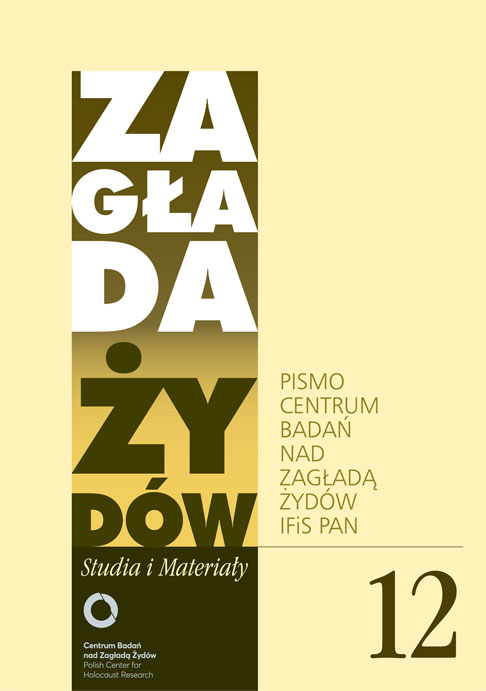Dutch Society and the Jewish Fate: A Puzzling Record
Zagłada Żydów. Studia i Materiały, No. 12 (2016), Pages: 425-434
Submission Date: 2020-10-20Publication Date: 2016-11-30
 https://doi.org/10.32927/ZZSiM.426
https://doi.org/10.32927/ZZSiM.426
Abstract
The percentage of victimization of Dutch Jewry during the Shoah is the highest of Western, Central and Southern Europe (except, perhaps of Greece), and close to the Polish one: 75%, more than 104.000 souls. The question of disproportion between the apparent favorable status of the Jews in society – they had acquired emancipation in 1796 - and the disastrous outcome of the Nazi occupation as compared to other countries in general and Western European in particular has haunted Dutch historiography of the Shoah. Who should be blamed for that outcome: the perpetrators, i.e. the Germans, the bystanders, i.e. the Dutch or the victims, i.e. the Dutch Jews? The article first surveys the answers given to this question since the beginnings of Dutch Holocaust historiography in the immediate post-war period until the debates of today and the factors that influenced the shaping of some basic perceptions on “Dutch society and the Jews”. It then proceeds to detailing several facts from the Holocaust period that are essential for an evaluation of gentile attitudes. The article concludes with the observation that – in spite of ongoing debates – the overall picture which has accumulated after decades of research will not essentially being altered. Although the Holocaust was initiated, planned and carried out from Berlin, and although a considerable number of Dutchmen helped and hid Jews and the majority definitely despised the Germans, considerable parts of Dutch society contributed to the disastrous outcome of the Jewish lot in the Netherlands – through a high amount of servility towards the German authorities, through indifference when Jewish fellow-citizens were persecuted, through economically benefiting from the persecution and from the disappearance of Jewish neighbors, and through actual collaboration (stemming from a variety of reasons). Consequently, the picture of the Holocaust in the Netherlands is multi-dimensional, but altogether puzzling and not favorable.
License
Copyright (c) 2016 Author&"Holocaust Studies and Materials"

This work is licensed under a Creative Commons Attribution 4.0 International License.
https://creativecommons.org/licenses/by/4.0
The journal is published under the Diamond Open Access Standard, CC-BY-4.0 Deed - Attribution 4.0 International - Creative Commons
Most read articles by the same author(s)
- Avner Shalev, Dan Michman, David Silberklang, Accurate Holocaust Memory at Yad Vashem’s Holocaust History Museum: A Response to Amos Goldberg , Zagłada Żydów. Studia i Materiały: No. 7 (2011)
Similar Articles
- Jacek Leociak, Understanding the Holocaust. A Task for Generations , Zagłada Żydów. Studia i Materiały: 2008: Holocaust Studies and Materials
- Roni Stauber, Philip Friedman and the Beginning of Holocaust Studies , Zagłada Żydów. Studia i Materiały: No. 11 (2015)
- Anna Abakunkova, Contemporary Holocaust Studies in Ukraine , Zagłada Żydów. Studia i Materiały: No. 10 (2014)
- Bartłomiej Krupa, Critical History and its ‘Shadow Cabinet’. Polish Historiography and the Holocaust during 2003–2013 , Zagłada Żydów. Studia i Materiały: No. Holocaust Studies and Materials (2017)
- Bartłomiej Krupa, Critical History and its “Shadow Cabinet.” Polish historiography on the Holocaust during 2003–2013 , Zagłada Żydów. Studia i Materiały: No. 10 (2014)
- Editors Journal, Jan Grabowski, From the editors , Zagłada Żydów. Studia i Materiały: 2010: Holocaust Studies and Materials
- Jacek Leociak, Marta Tomczok, Affective Holocaust Kitsch – Introduction , Zagłada Żydów. Studia i Materiały: No. 17 (2021)
- Przemysław Czapliński, The Holocaust as a Horror. A Handful of Comments on Polish Literature during 1985–2015 , Zagłada Żydów. Studia i Materiały: No. 12 (2016)
- Yehuda Bauer, Nowogródek – the Story of a Shtetl , Zagłada Żydów. Studia i Materiały: No. 3 (2007)
- Stephan Lehnstaedt, German Occupants in Warsaw and the Publicness of the Holocaust , Zagłada Żydów. Studia i Materiały: No. 12 (2016)
1 2 3 4 5 6 7 8 9 10 11 12 13 14 15 16 17 18 19 20 21 22 23 24 25 26 27 28 29 30 31 32 33 34 35 36 37 38 39 40 41 42 43 44 45 46 47 48 49 50 > >>
You may also start an advanced similarity search for this article.
 English
English
 Język Polski
Język Polski



 https://orcid.org/0000-0001-7496-496X
https://orcid.org/0000-0001-7496-496X

